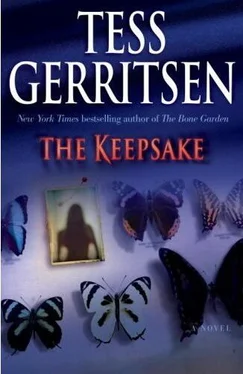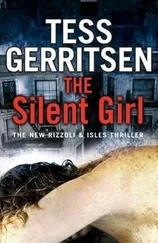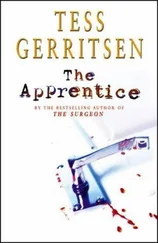Her kitchen telephone rang, shattering the silence. Startled, she felt her pulse give a kick as she rose from the chair. How easily Sansone was able to rattle her belief in a logical world. How quickly he could cast a shadow over a bright summer day. His paranoia was contagious, and she heard an ominous note to that ringing telephone, a warning that this call would bring unwelcome news.
But the voice that greeted her on the line was both familiar and pleasant. “Dr. Isles, this is Carter from the lab. I have some interesting GC-MS results.”
“On what?”
“Those tissue samples you sent us on Thursday.”
“From the body in the trunk? You’ve already done the gas chromatography?”
“I got a call to come into the lab for a weekend expedite. I thought you ordered it.”
“No, I didn’t.” She glanced over her shoulder at Sansone, who was watching her so closely that she felt compelled to turn away.
“Go on,” she said into the phone.
“I did a flash pyrolysis on the tissue sample, and I found ample presence of both collagenous and noncollagenous proteins when we examined it with gas chromatography and mass spectrometry. Whatever its age, this tissue is really well preserved.”
“I also requested a screen for tanning agents. Did you find any?”
“There aren’t any benzenediols present. That eliminates most known tanning agents. But it did detect a chemical called four-isopropenylphenol.”
“I have no idea what that means.”
“I had to do some research myself. That chemical turns out to be a characteristic pyrolysis product of sphagnum moss.”
“Moss?”
“Yeah. Does that help you at all?”
“Yes,” she said quietly. “I think it does.” It tells me exactly what I need to know. She hung up and stood staring at the phone, stunned by the lab results. This was now beyond her sphere of knowledge, beyond anything she’d ever dealt with in the autopsy room, and she did not want to proceed without technical guidance.
“Maura?”
She turned to Sansone. “Can we continue this discussion another time? I need to make some phone calls.”
“May I make a suggestion before I leave? I know a gentleman you might want to contact. A Dr. Pieter Vandenbrink. I can put you in touch with him.”
“Why are you telling me about him?”
“You’ll find his name well represented on the Internet. Look up his curriculum vitae, and you’ll understand why.”
The TV news vans were back, and this time, there were more of them. Once a killer earns a nickname, he becomes public property, and every news station wanted a piece of the Archaeology Killer investigation.
Jane felt the all-seeing eyes of the cameras following her as she and Frost walked from the parking lot to the ME’s building. When she’d first made detective, she’d gotten a thrill seeing herself for the first time on the evening news. That thrill had long since faded, and these days she viewed reporters with irritation. Instead of mugging for the cameras, she walked with her head down and her shoulders rolled forward; on the six o’clock news tonight, she’d probably look like a hunchbacked troll in a blue blazer.
It was a relief to step inside the building and escape the invasive zoom lenses, but the worst ordeal lay ahead. As she and Frost made their way to the autopsy lab, she felt her muscles tensing, her stomach churning in anticipation of what they’d have to confront on the table today.
In the anteroom, Frost was unusually silent as they both donned gowns and shoe covers. Braving a glimpse through the window, she was relieved to see that the body was still covered by a drape, a brief reprieve before the horror. With a grim sense of duty, she pushed into the autopsy room.
Maura had just clipped X-rays onto the morgue viewing box, and the dental films of Jane Doe Number Three glowed against the backlight. She looked at the two detectives. “So what do you think of these?” she quizzed them.
“Those look like pretty good teeth,” said Jane.
Maura nodded. “There are two amalgam fillings here, plus one gold crown on the lower left molar. I see no caries, and there’s no alveolar bone loss to indicate any periodontal disease. Finally, there’s this detail.” Maura tapped a finger on the X-ray. “She’s missing both pre-molars.”
“You think they were pulled?”
“But there are no gaps between the teeth. And the roots of these incisors have been shortened and blunted.”
“And that means?”
“She’s had orthodontic work. She’s worn braces.”
“So we’re talking a well-to-do victim.”
“Certainly middle class, at the very least.”
“Hey, I never got braces.” Jane bared her teeth, revealing an irregular bottom row. “These, Doc, are middle-class teeth.” She pointed to the X-ray. “My dad couldn’t afford to pay for something like that.”
“Madam X had good teeth, too,” said Frost.
Maura nodded. “Both women had what I’d guess were privileged childhoods. Privileged enough to pay for good dental care and orthodontics.” She pulled down the dental film and reached for a new set, which twanged as she shoved them under the clips. The bones of the lower extremities now glowed on the light box.
“And here’s what else the two victims had in common.”
Jane and Frost simultaneously sucked in startled breaths. They needed no radiologist to interpret the damage they saw on those X-rays.
“It was done to both of her tibias,” said Maura. “With a blunt instrument of some kind. A hammer maybe, or a tire iron. We’re not talking about mere glancing blows on her shins. These were brutal and purposeful, meant to shatter bone. Both tibias have transverse diaphyseal fractures, with scattered fragments embedded in the soft tissue. The pain would have been excruciating. She certainly couldn’t have walked. I can’t imagine how she must have suffered over the days that followed. Infection probably set in, spreading from open wounds into soft tissues. Bacteria would have infiltrated bone, and eventually blood.”
Jane looked at her. “Did you say days?”
“These fractures wouldn’t have been fatal. Not immediately.”
“Maybe she was killed first. These could be postmortem mutilations.” Please make them postmortem, and not what I’m imagining.
“I’m sorry to say that she lived,” said Maura. “For at least several weeks.” She pointed to a ragged outline, like a puff of white smoke surrounding the fractured bone. “This is callus formation. It’s the bone healing itself, and this doesn’t happen overnight, or even over a few days. It takes weeks.”
Weeks during which this woman had suffered. Weeks when it must have seemed far better to die. Jane thought of an earlier set of X-rays she’d seen hanging on this same light box. Another woman’s shattered leg, the fracture lines blurred by a fog of healing bone.
“Just like Madam X,” she said.
Maura nodded. “Neither of these victims was killed immediately. Both suffered crippling injuries to their lower extremities. Both lived for a while. Which means someone brought them food and water. Someone was keeping them alive, long enough for the first signs of healing to show up on these films.”
“It’s the same killer.”
“The patterns are too similar. This is part of his signature. First he maims them, maybe to ensure they can’t escape. Then as the days go by, he keeps them fed. And alive.”
“What the hell is he doing during that time? Enjoying their company?”
“I don’t know.”
Jane stared at shattered bone and felt a twinge in her own legs, just a shadow of the agony this victim must have endured. “You know,” she said softly, “when you first called me that night about Madam X, I thought it would be an old murder. A cold case, with a perp who was long dead. But if he’s the one who put this body in Ms. Pulcillo’s car…”
Читать дальше












